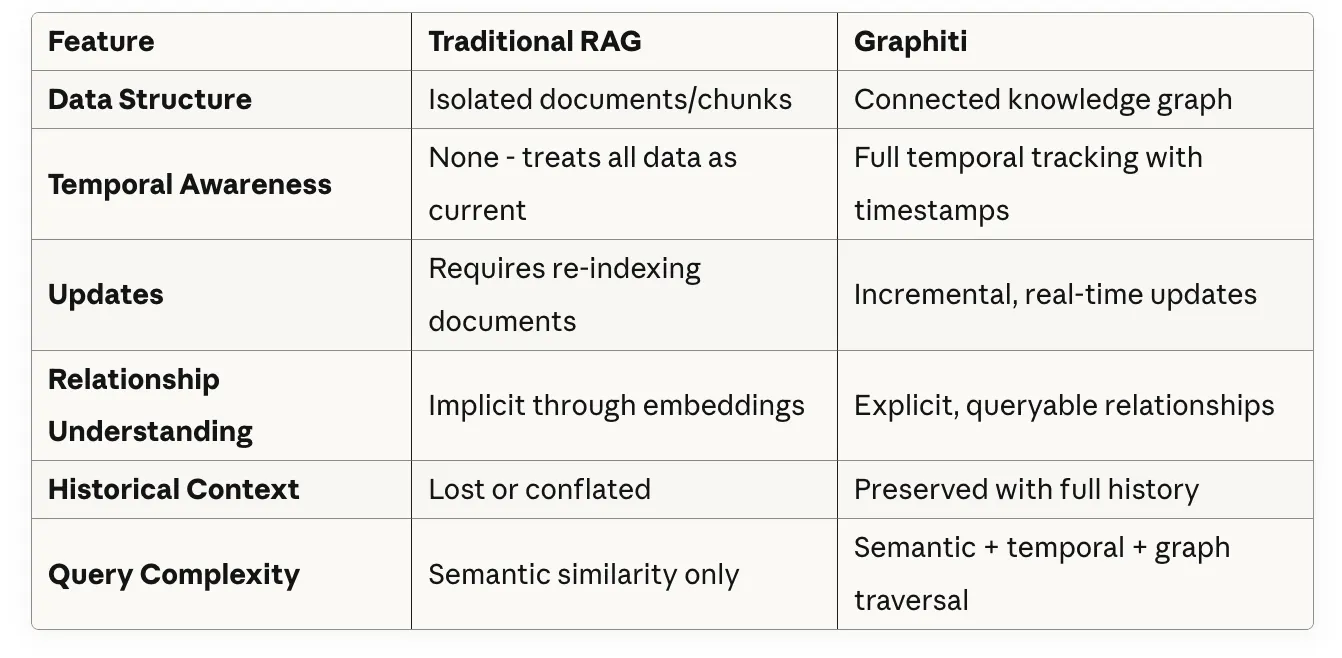
The next frontier in AI isn’t just about smarter models; it’s about memory that evolves with time.
The Context Retention Challenge
We’ve all experienced it: you’re having a conversation with an AI assistant, sharing context about your project, your preferences, and your work. Then you start a new session, and it’s like meeting a stranger all over again. The AI doesn’t remember. It doesn’t connect the dots. It treats every interaction as an isolated event.
Traditional Retrieval-Augmented Generation (RAG) systems made strides in giving AI access to external knowledge, but they operate like a library of disconnected books. Each document sits alone, unaware of how it relates to others, unable to capture the dynamic, evolving nature of real-world information.
What if AI could remember not just what happened, but when it happened and how things changed over time? What if it could understand that your preferences evolved, that relationships between concepts shifted, and that yesterday’s truth might be today’s outdated information?
The answer is Graphiti.
What is Graphiti?
Graphiti is a Python framework designed for building knowledge graphs that are temporally aware and specifically tailored for AI agents. It serves as a real-time knowledge graph engine that incrementally processes new data, immediately updating entities, relationships, and community structures, without relying on periodic batch recomputation. This enables AI agents to have a dynamic memory system that not only stores facts but also understands how information and connections change over time.
With seamless integration for popular graph databases such as Neo4j (the primary recommended option), AWS Neptune, and FalkorDB, Graphiti supports flexible and robust data backends. Its architecture is particularly suited for environments where the timing and evolution of relationships are crucial for reasoning and adapting to new information.
The Knowledge Graph Foundation
At its core, a knowledge graph is a network of interconnected facts, where each fact is a “triplet” represented by two entities, or nodes, and their relationship, or edge. For example: “Sarah” (node) “works at” (edge) “TechCorp” (node).
But Graphiti takes this further. It doesn’t just store this triplet—it knows when Sarah started working at TechCorp, and if she changes jobs, it maintains both the historical and current relationships.
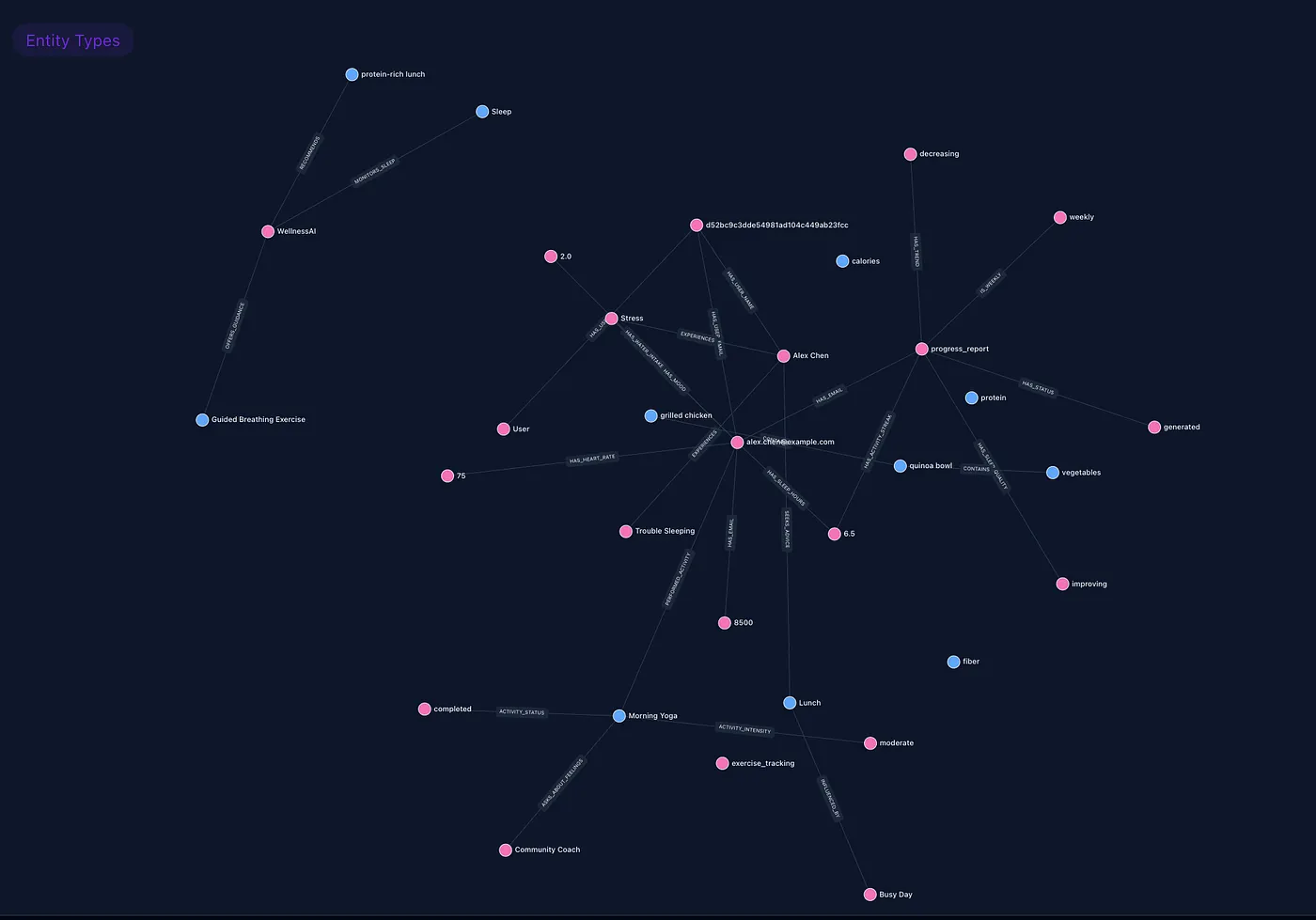
Why Temporal Awareness Matters
Temporal awareness means the system knows when facts were true, not just what they are, giving AI a sense of time and how information evolves.
Consider a customer support AI tracking user account status:
Document 1 (March 2024): "Customer on Free Plan, reporting slow performance"
Document 2 (July 2024): "Customer upgraded to Enterprise Plan"
Document 3 (Sept 2024): "Customer downgraded to Pro Plan due to budget cuts"Traditional systems retrieve all three and can’t determine current status. With Graphiti’s temporal awareness:
- Free Plan (March 2024—July 2024)—Historical
- Enterprise Plan (July 2024—Sept 2024)—Historical
- Pro Plan (Sept 2024—present)—Current
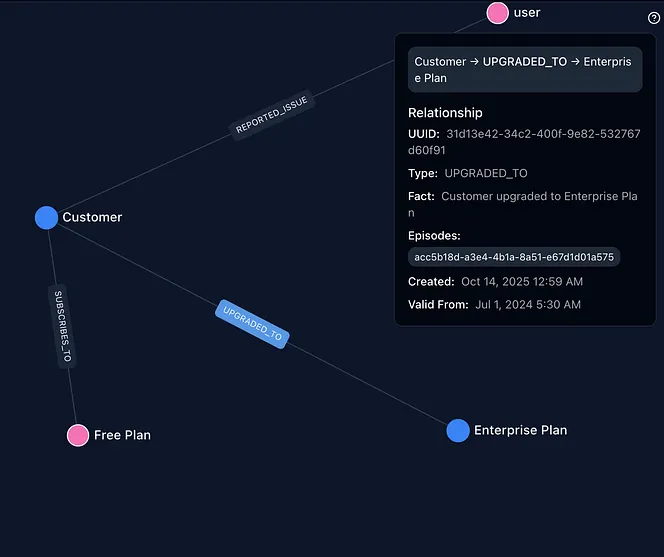
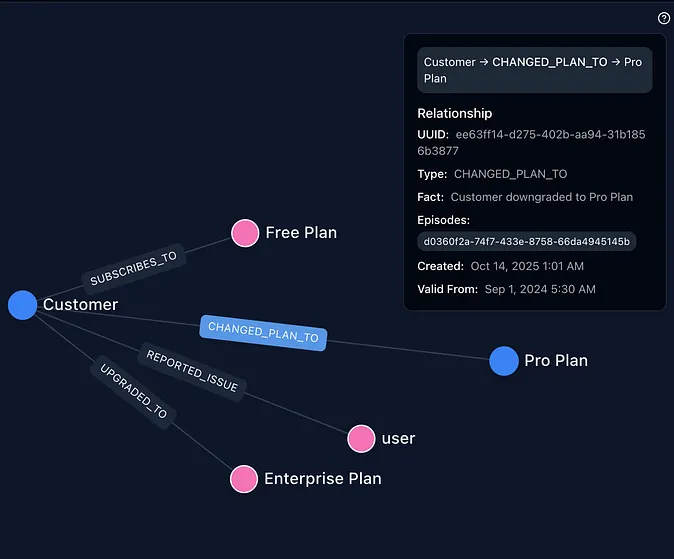
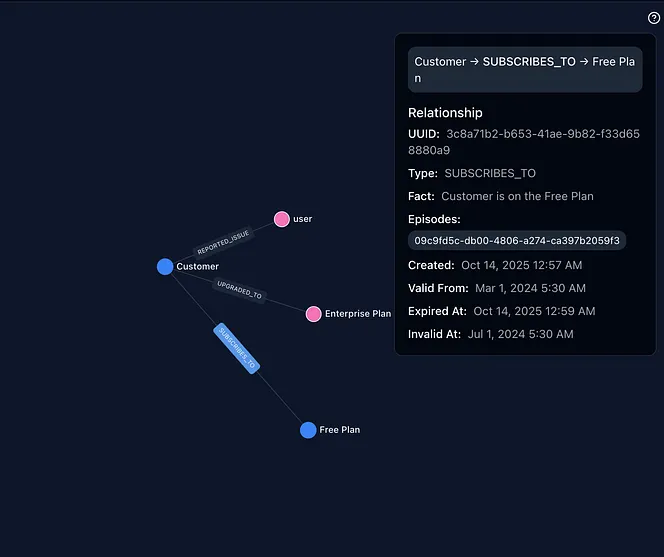
The AI answers confidently: “You’re currently on our Pro Plan. I see you previously experienced performance issues on the Free tier—those shouldn’t occur on your current plan.” The system understands the customer’s journey and provides contextually relevant support.
Graphiti vs. Traditional RAG: A Comparison
Key Components
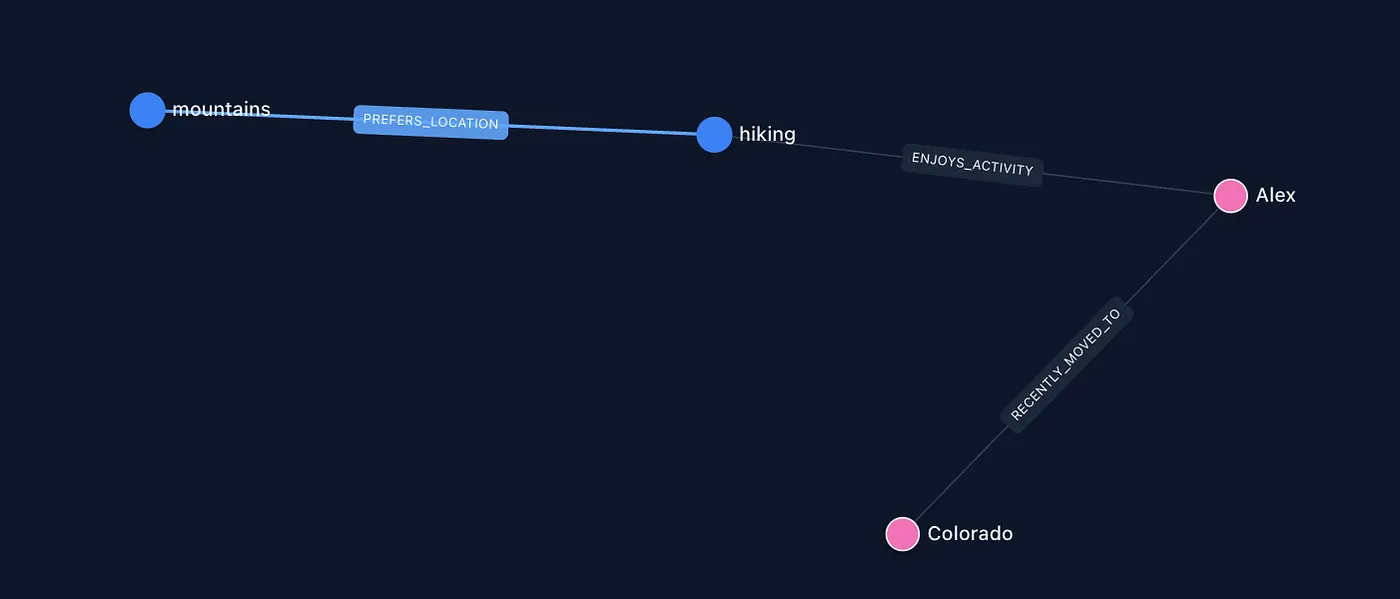
- Episode Ingestion: Graphiti processes “episodes,” discrete pieces of information or interactions. These could be chat messages, documents, API responses, or any data source.
- Entity Extraction: Using LLMs, Graphiti automatically identifies entities (people, places, concepts) within episodes.
- Relationship Mapping: It discovers and creates relationships between entities, understanding context and nuance.
- Temporal Indexing: Every entity and relationship is timestamped, creating a historical record of how knowledge evolved.
- Incremental Updates: Unlike traditional systems, it enables real-time, incremental updates to knowledge graphs without batch recomputation.
The Graphiti Pipeline
Now let’s see how the above components work together in practice:
from graphiti_core import Graphiti
from graphiti_core.nodes import EpisodeType
import asyncio# Initialize Graphiti with your graph database
graphiti = Graphiti("bolt://localhost:7687", "neo4j", "password")async def build_agent_memory():
# Add an episode (interaction/event)
await graphiti.add_episode(
name="user_conversation",
episode_body="User mentioned they love hiking in the mountains and recently moved to Colorado",
source=EpisodeType.message,
source_description="User chat message"
)
# The graph automatically extracts:
# - Entities: User, hiking, mountains, Colorado
# - Relationships: User -> loves -> hiking
# User -> moved_to -> Colorado
# - Temporal markers: "recently" indicates recency
# Later, query with temporal context
results = await graphiti.search(
query="What are the user's current interests?",
num_results=5
)
return results
# Run the async function
asyncio.run(build_agent_memory())The Graphiti Advantage: Real-World Use Cases
-
Intelligent Customer Support Agents
Imagine a customer support AI that remembers:
- the products a customer purchased (and when)
- Previous issues they reported (and resolutions)
- Changes in their account status over time
- Evolving preferences and feedback
When a returning customer asks for help, the agent can say, “I see you purchased the Pro plan in March and upgraded to Enterprise in September. You previously reported latency issues, which we resolved. How can I help you today?” Without temporal awareness, the AI might reference a customer’s old Free Plan issues when they’re now on Enterprise, causing confusion and frustration.
-
Personal AI Assistants
A true personal assistant should understand:
- Your career progression over time
- How your skills and interests evolved
- Relationships with colleagues, friends, and family
- Context from months or years of interactions
Graphiti enables assistants to provide contextually aware suggestions based on your entire history, not just recent conversations. Traditional systems without temporal context might suggest career opportunities in fields you left years ago, because they can’t distinguish between past and current interests.
-
Research and Analysis Tools
For researchers analyzing evolving situations like market trends, competitive landscapes, and scientific developments. Graphiti can:
- Track how entities and relationships change over time
- Identify emerging patterns and connections
- Maintain complete historical context for analysis
- Support “point-in-time” queries: “What did we know about Company X in Q2 2024?”
Market conditions evolve rapidly, and temporal graphs preserve the complete historical context, allowing researchers to understand not just the current state but also how we got here.
-
Compliance and Audit Systems
In regulated industries, temporal knowledge is critical:
- Track when policies changed
- Maintain audit trails of decisions and rationale
- Understand historical context of compliance requirements
- Support forensic analysis with temporal queries
Knowing when decisions were made and what information was available at that moment is legally critical; static systems can’t provide this historical context.
Challenges and Considerations
While Graphiti represents a significant advancement, it’s important to understand the tradeoffs:
- Computational Overhead—Building and maintaining temporal knowledge graphs requires more computational resources than simple vector storage. LLM-based entity extraction and relationship inference add latency.
- Data Quality—Garbage in, garbage out. The quality of your knowledge graph depends heavily on the quality of input data and the accuracy of entity extraction.
- Graph Complexity—As knowledge graphs grow, managing complexity becomes challenging. Proper entity resolution and relationship pruning strategies are essential.
- Cost—Using LLMs for entity extraction and relationship inference can be expensive at scale. Consider your use case and budget accordingly.
- Entity resolution—This becomes increasingly critical as your graph scales. The system must accurately determine whether ‘Sarah Johnson,’ ‘S. Johnson,’ and ‘the new engineer’ all refer to the same person.Graphiti uses semantic similarity and contextual clues, but ambiguous cases require careful handling, particularly in domains where precision matters, like healthcare or legal systems.
The Future of AI Memory
Graphiti now includes a Model Context Protocol (MCP) server, giving Claude, Cursor, and other MCP clients powerful knowledge graph-based memory. This represents a fascinating convergence: AI models with persistent, evolving memory accessible across different applications and contexts.
With this, AI agents interact with Graphiti through tool calls, programmatic interfaces that allow agents to store information, retrieve context, and query relationships on demand. When you ask an agent a question, it can call Graphiti’s search function to retrieve relevant memories or use graph traversal to explore connections between entities. This tool-based integration means Graphiti becomes an extension of the agent’s reasoning capabilities.
Imagine a future where:
- Your AI coding assistant remembers your entire codebase evolution.
- Medical AI systems track patient histories with perfect temporal fidelity.
- Financial AI agents understand market dynamics through time-aware knowledge graphs.
- Educational AI tutors adapt to your learning journey over months and years.
Unlike traditional RAG approaches that rely on static data, Graphiti continuously integrates user interactions and business data into dynamic, queryable graphs while maintaining historical context. This isn’t just an incremental improvement; it’s a fundamental shift in how AI systems remember and reason.
